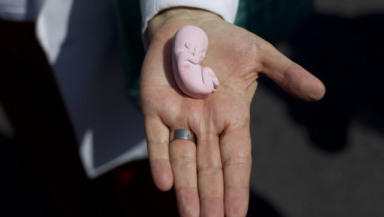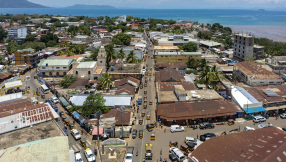
Russian President Vladimir Putin signed a new amendment to the country's healthcare laws on Monday that made abortion clinic advertising a crime carrying potentially hefty fines.
The prohibition blocks surgeries that specialise in abortion from advertising on TV, radio, in cinemas, through videos, and on all forms of public transport.
The adverts are also banned from the first and last pages of any publication for adults. If the publication is aimed at children, it is banned on all pages, as well as in the premises of any organisation aimed at serving children.
The fines for breaking the law are relatively small for individuals, ranging from around 2000 roubles (around £40) to 30,000 roubles (around £570), but are substantial for companies and any 'legal person', at 500,000 roubles (around £9,500).
The law was part of a new initiative to take greater control of medical advertising in general. Other provisions include a ban on any advertising for certain 'traditional' medical practices, and on free samples of narcotic or psychotropic substances.
Women's rights activist Olgerta Kharitonova said the ban on abortion ads was "not the beginning of the restriction of women's [reproductive] rights, but rather the continuation of a process begun in 2011".
She was referring to laws that limit abortion to the twelfth week of a pregnancy, as well as enforcing a 48-hour waiting period.
Russia also prohibits abortion for medical reasons after 22 weeks, and heavily regulates medical abortions so that they can only be carried out by specially licenced clinics.
Campaigners behind Russia's recent law on "gay propaganda" are pushing for laws to go further by making the morning after pill a prescription only drug, and imposing stricter punishments for unlicensed abortion providers.
These measures are all part of President Putin's promise to stem the problem of population decline in Russia. United Nations projections show that unless current trends change, Russia's population will drop from its current level of 143 million to between 110 and 100 million by 2050, although there has been some slow growth since 2009's recent low of 141.9 million.
Abortion is seen as a large cause of this problem. Life-Site News reports that there are 1,022 abortions in Russia for every 1,000 live births. By comparison, in the UK in 2011, there were approximately 262 abortions for every 1,000 live births.
Duma MP Elena Mizulina said at a recent celebration of the 400th anniversary of the Romanov dynasty, "The problems of abortion prevention and the shift in public opinion towards abortion are currently very urgent. Although the number of abortions in Russia is falling, it still exceeds five million every year.
"Humanity will probably understand one day that as we ban nuclear weapons to prevent the death of Mother Earth, so should we ban the technology destroying the natural environment and natural childbirth, the natural way of human reproduction."
Last October, the Russian Orthodox Church described abortions and surrogacy as "mutiny against God".
MP Anton Belyakov, from the Just Russia party, and the main author of the 2011 bill that limited abortion to 12 weeks, was quoted on Life-Site News in 2011 as saying that 90 per cent of abortions in Russia are done for "social" rather than medical reasons.
Putin's responses to this demographic crisis have revolved around the praising of traditional values, and citing the Russian Orthodox Church as a moral guide. Policy implementations have included: • A provision of 2.57 million roubles for the birth of every child (approximately £5,500). • Banning all abortion providers from describing abortion as a "safe medical procedure". • Requiring doctors to explain the infertility risks and potential health problems before performing an abortion. • A ban on the adoption of children from the US. • The foundation of a national day of fertility.
His initial 2003 limitations on abortion were the first Russia had seen in more than 50 years.
Other measures currently under discussion to solve Russia's declining population include: • A monthly 2000 rouble (£42) subsidy for all mothers • Banning coverage for abortions as part of any health insurance scheme • Parental consent for abortions for the under 17s • Extending the required waiting period for an abortion to a week • Laws preventing a married woman from getting an abortion without her husband's consent
There has also been a large scale effort by the government to spread the cultural norm of a three child Russian family, however recent publicity around this has caused some national embarrassment.
The Russian newspaper Moskovskiya Vedemosti recently published a story on their website about the ban on US adoptions by Russian parents, and included what was believed to be a stock picture of a traditional Orthodox Russian family. The picture was in fact of Andriy Sadovyy, the Catholic mayor of the Ukrainian city of Lviv and his family.
Russia has an interesting history in relation to abortion. When it was legalised under Lenin in 1920, making Russia one of the first countries to do so, there were no limitations on it. Abortions could be had theoretically right up until labour. By 1934 women in Moscow were having three abortions per live birth.
In response to what was perceived as the danger of a vanishing population, Stalin banned abortion in 1936. In 1955 Khrushchev re-legalised abortion, again with no restrictions, leading to a peak in abortions in 1965 of 8.2 million per year.
In 1970, there were approximately 3,000 full-time abortion doctors were performing 7.2 million abortions per year. By the 1980s, citizens of the USSR comprised 5 to 6 per cent of the world's population but performed 25 per cent of the world's abortions.
In February 2003 the Washington Post reported that 13% of Russian couples were infertile. In nearly three quarters of those cases, infertility was attributed to the woman as a result of complications arising from either one or more than one abortions.
President Putin has previously pledged that 1.5 trillion roubles (£27.516 billion) will be invested in "demography projects," to improve the average life expectancy and to boost the birth rate by 25 to 30 percent over three years.













